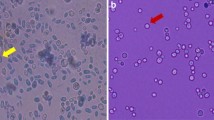Summary
One hundred forty sevenCandida albicans strains isolated from different clinical specimens were serologically differentiated. Agar gel diffusion test inBjörklund modification was applied inCandida albicans grouping. Autolysates prepared from the strains under study and from the group A and B standard strains ofHasenclever were used as antigens against anti-Candida albicans group A rabbit immune sera. Among 147 examined strains isolated from 107 patients, 137 strains were classified as belonging to group A and only 10 (9.3 %) strains as belonging to group B.
Similar content being viewed by others
References
Björklund B. (1952). Specific inhibition of precipitation as an aid in antigen analysis with gel diffusion method. Proc. Soc. exp. Biol. Med.,79, 319–324.
Drouhet, E. &Vieu, M. (1957). Biologie des infections à Candida. I. Diagnostic de Laboratoire. Sem. Hôp. Paris,33, 793–807.
Hasenclever, H. F. &Mitchell, W. O. (1961). Antigenic studies of Candida. I. Observation of two antigenic groups in Cancida albicans. J. Bact.,82, 570–573.
Hasenclever, H. F. &Mitchell, W. O. (1961). Antigenic studies of Candida. III. Comparative pathogenicity of Candida albicans group A, group B and Candida stellatoidea. J. Bact.,82, 578–581.
Hasenclever, H. F. &Mitchell, W. O. (1963). Antigenic studies of Candida. IV. The relationship of the antigenic groups of Candida albicans to their isolation from various clinical specimens. Sabouraudia,2, 201–204.
Ouchterlony, O. (1949). Antigen-antibody reactions in gels. Acta path. microbiol. scand.,26, 507.
Pavlatou, M. &Marcelou, U. (1956). Milieu favorisant la formation des chlamydospores de Candida albicans. Ann. Inst. Pasteur,91, 410–413.
Sandula, J., Kockova-Kratochvilova, A. &Zamecnikova, M. (1964). Serologische Studie über Kulturhefen. Brauwissenschaft,17, 130–137.
Stallybrass, F. C. (1964). Candida precipitins. J. Path. Bact.87, 89–97.
Stallybrass, F. C. (1964). The incidence of serological groups of Candida albicans in southern England. J. Hyg. Camb.,62, 395–399.
Widra, A. (1957). An improved fermentation method for rapid identification of Candida species. J. infect. Dis.,100, 70–73.
Author information
Authors and Affiliations
Rights and permissions
About this article
Cite this article
Laskownicka, Z., Porebska, A. & Zemburowa, K. The serological grouping of Candida albicans strains isolated in the Kraków province in the years 1963–1965 by means of agar gel diffusion test. Mycopathologia et Mycologia Applicata 33, 10–16 (1967). https://doi.org/10.1007/BF02049785
Issue Date:
DOI: https://doi.org/10.1007/BF02049785




